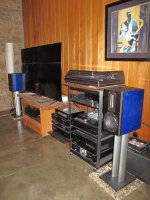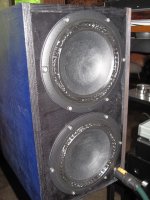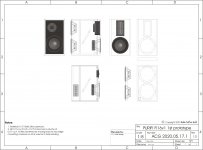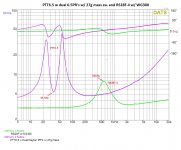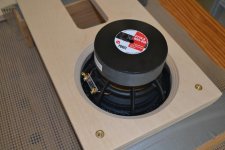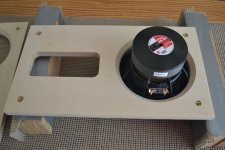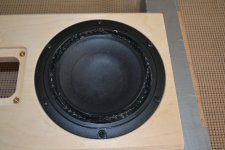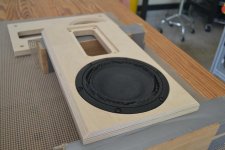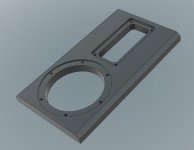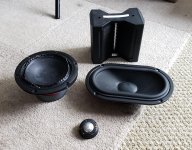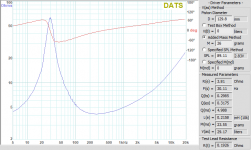Pictures and a diagram of my first PURIFI design Fi16v1 (Purifi drivers in 16 liter enclosure version 1) it uses PTT6.5W04 woofers (one per speaker), PTT6.5PR passive radiators (two per speaker), and Fountek CD 2.0 ribbon tweeter. Crossover is external and should not even be considered a preliminary design. It is repurposed from my NT10 design as a stand in while drivers are measured and Fi16 crossovers (both passive and active) are designed. DSP in JRiver music player software was used to correct the 8.5 dB difference in sensitivity between woofer and tweeter. This is the speaker yielding the results for the listening report I will post next.
Attachments
In the report of the first listen at late night background levels to my speaker system based on PURIFI PTT6.5W04 drivers I call Fi16v1 I promised “will post follow up listening notes with unconstrained volume levels”. Here is that report based on a week of listening.
At background, normal, and high listening levels it is constantly apparent that PURIFI have delivered on their goal of significantly reducing distortion and extending bandwidth of the 6.5 inch 165 mm class woofer/midrange. The improvements over the previous state of the art I am familiar with are plainly audible across the drivers’ entire bandwidth.
What I find thrilling and the fulfillment of PURIFI’s promise to have ‘cracked the long stroke code’ can be illustrated describing how they reproduce the cut “Morning Mist” from “Ahmad Jamal: Live in Marciac: August 5, 2014”. This track is largely a solo showcase for bassist Reginald Veal with pianist-composer Ahmad Jamal, drummer Herlin Riley and percussionist Manolo Badrena joining in with occasional flourishes and as an ensemble at the end. In hi-fi engineering we have a dilemma. The path to low distortion leads to chasing every resonance out of the system while paradoxically the sounds we wish to reproduce are full of, literally made using, resonance’s. Case in point is Veal’s bass. As he solos through “Morning Mist” he is playing sparsely, deliberately using decades of skill to coax the sounds he is weaving into music from his instrument. Too often with hi-fi by the time our speakers are tamed into low distortion and uncolored sound the music that emerges is homogenized and bleached. Those two adjectives are a bit excessive for what I am trying to describe. The Accuton woofers in the system I moved aside for the Fi16v1 are anything but ‘slow’ or ‘dull’. What PURIFI brings is that when Veal strokes or then in contrast firmly plucks a string the resonant nature of the device making the sounds is so wonderfully explicit. These speakers absolutely love bass players, here Veal begins simply plucking the melody out one note at a time, when his runs descend down the E string the power so effortlessly generated by a tuned resonant device is reproduced with unaccustomed clarity. Some reviewers call this ‘jump factor’ when the sound scales the dynamic range so easily the listener is startled. Also at play here is that the trailing side of sounds are tracked unusually well, the previous notes are reproduced then we have a quiet from which the next note emerges. Four minutes into the track and Veal is sprinting through the notes and the PURIFI’s skill at the pace, rhythm, and timing aspect of hi-fi is demonstrated. By six minutes in the solo is winding down, the appreciative audience applauding as Ahmad Jamal enters softly playing the melody. While the percussionists add little sparkles the solo becomes a duet between stand up bass and grand piano. The tonality of the instruments is reproduced with great delicacy and the duet+ at times seems a bit of a jazz duel as Veal and Jamal each add power and density to their playing. And then they expertly take it home the pace and intensity trailing off with the empty space between the notes finishing the story. With a final declarative note Jamal signals the band and audience its over. And then a quiet ‘thunk’ is heard, it’s the sound of the piano’s dampers releasing onto the strings. That sound has to be many 10s of dB’s down into the noise yet there it is.
Ok, enough of this tonal beauty, delicacy, and filigreed finesse, what about big bass? Ok, as an ardent fan of progressive rock like Yes, ELP, Genesis, Jethro Tull first stop is of course Pink Floyd DSOTM the faded up heartbeat on ‘Speak To Me’. The depth of the manipulated bass sound is there in full and as the music transitions into the following cuts many times the extreme deep bass underpinning the work is fully present and accounted for. Its 1970s stadium rock so of course we also have plenty of guitar leads soaring over the proceedings. The PURIFI’s party trick on Floyd or a Philharmonic is how they simultaneously reproduce subwoofer deep bass along with very clean and clear midrange. Skipping forward a quarter century the audio show fav ‘Indus’ off Dead Can Dance’s Spiritchaser allows the PURIFI’s to show how they cope with really deep synth bass. Here let’s just say ‘wow’. The woofers and passive radiators were really dancing on this track. Given the levels of energy this woofer is capable of putting into both the room and reaction forces into the enclosure system I am considering ways to fasten them to the stands and in later designs incorporate extreme measures like sand filled damping chambers.
The most impressive track for hearing the PURIFI’s bass capability is…..every track, movie, and TV program. Rather than look for the hi-fi demo piece cranked up just go about your regular listening at normal levels. The first thing you’ll notice, and quickly get used to, is how easy it is to hear all manner of detail about what’s going on in the bass and mid-bass. And then every so often along comes something in the deep bass and its another ‘wow’ moment.
The above paragraphs read like I’m reviewing a subwoofer, bass this and bass that and bass bass bass. The bass is what leaps out as different and better than the norm when first listening to PURIFI transducers. But the bass is not even half the story. All the measures to reduce distortion and compression effects are also immediately audible and all for the good. Over my decades as an audiophile (sigh…so dang old) one of the characteristics I have learned to listen for while judging hi-fi is how apparent and revealed are the fine details of the textures of the musical instruments and voices used to create the work being played back. Across its full range the PURIFI transducers deliver an overflowing abundance of such nuances and filigreed tonal textures. But its not the delicate wispy detail of a electrostat because here that detail is riding along a dynamic capability and ease one usually hears from large format horn speakers. I suspect the lowering of distortion and ringing combined with dynamics unleashed due to previously unidentified hysteresis effects here addressed sum to this great effect. Then those details and dynamics combine with the openness and low coloration the mini-monitor architecture is so well known for. Result is pure musical bliss.
At background, normal, and high listening levels it is constantly apparent that PURIFI have delivered on their goal of significantly reducing distortion and extending bandwidth of the 6.5 inch 165 mm class woofer/midrange. The improvements over the previous state of the art I am familiar with are plainly audible across the drivers’ entire bandwidth.
What I find thrilling and the fulfillment of PURIFI’s promise to have ‘cracked the long stroke code’ can be illustrated describing how they reproduce the cut “Morning Mist” from “Ahmad Jamal: Live in Marciac: August 5, 2014”. This track is largely a solo showcase for bassist Reginald Veal with pianist-composer Ahmad Jamal, drummer Herlin Riley and percussionist Manolo Badrena joining in with occasional flourishes and as an ensemble at the end. In hi-fi engineering we have a dilemma. The path to low distortion leads to chasing every resonance out of the system while paradoxically the sounds we wish to reproduce are full of, literally made using, resonance’s. Case in point is Veal’s bass. As he solos through “Morning Mist” he is playing sparsely, deliberately using decades of skill to coax the sounds he is weaving into music from his instrument. Too often with hi-fi by the time our speakers are tamed into low distortion and uncolored sound the music that emerges is homogenized and bleached. Those two adjectives are a bit excessive for what I am trying to describe. The Accuton woofers in the system I moved aside for the Fi16v1 are anything but ‘slow’ or ‘dull’. What PURIFI brings is that when Veal strokes or then in contrast firmly plucks a string the resonant nature of the device making the sounds is so wonderfully explicit. These speakers absolutely love bass players, here Veal begins simply plucking the melody out one note at a time, when his runs descend down the E string the power so effortlessly generated by a tuned resonant device is reproduced with unaccustomed clarity. Some reviewers call this ‘jump factor’ when the sound scales the dynamic range so easily the listener is startled. Also at play here is that the trailing side of sounds are tracked unusually well, the previous notes are reproduced then we have a quiet from which the next note emerges. Four minutes into the track and Veal is sprinting through the notes and the PURIFI’s skill at the pace, rhythm, and timing aspect of hi-fi is demonstrated. By six minutes in the solo is winding down, the appreciative audience applauding as Ahmad Jamal enters softly playing the melody. While the percussionists add little sparkles the solo becomes a duet between stand up bass and grand piano. The tonality of the instruments is reproduced with great delicacy and the duet+ at times seems a bit of a jazz duel as Veal and Jamal each add power and density to their playing. And then they expertly take it home the pace and intensity trailing off with the empty space between the notes finishing the story. With a final declarative note Jamal signals the band and audience its over. And then a quiet ‘thunk’ is heard, it’s the sound of the piano’s dampers releasing onto the strings. That sound has to be many 10s of dB’s down into the noise yet there it is.
Ok, enough of this tonal beauty, delicacy, and filigreed finesse, what about big bass? Ok, as an ardent fan of progressive rock like Yes, ELP, Genesis, Jethro Tull first stop is of course Pink Floyd DSOTM the faded up heartbeat on ‘Speak To Me’. The depth of the manipulated bass sound is there in full and as the music transitions into the following cuts many times the extreme deep bass underpinning the work is fully present and accounted for. Its 1970s stadium rock so of course we also have plenty of guitar leads soaring over the proceedings. The PURIFI’s party trick on Floyd or a Philharmonic is how they simultaneously reproduce subwoofer deep bass along with very clean and clear midrange. Skipping forward a quarter century the audio show fav ‘Indus’ off Dead Can Dance’s Spiritchaser allows the PURIFI’s to show how they cope with really deep synth bass. Here let’s just say ‘wow’. The woofers and passive radiators were really dancing on this track. Given the levels of energy this woofer is capable of putting into both the room and reaction forces into the enclosure system I am considering ways to fasten them to the stands and in later designs incorporate extreme measures like sand filled damping chambers.
The most impressive track for hearing the PURIFI’s bass capability is…..every track, movie, and TV program. Rather than look for the hi-fi demo piece cranked up just go about your regular listening at normal levels. The first thing you’ll notice, and quickly get used to, is how easy it is to hear all manner of detail about what’s going on in the bass and mid-bass. And then every so often along comes something in the deep bass and its another ‘wow’ moment.
The above paragraphs read like I’m reviewing a subwoofer, bass this and bass that and bass bass bass. The bass is what leaps out as different and better than the norm when first listening to PURIFI transducers. But the bass is not even half the story. All the measures to reduce distortion and compression effects are also immediately audible and all for the good. Over my decades as an audiophile (sigh…so dang old) one of the characteristics I have learned to listen for while judging hi-fi is how apparent and revealed are the fine details of the textures of the musical instruments and voices used to create the work being played back. Across its full range the PURIFI transducers deliver an overflowing abundance of such nuances and filigreed tonal textures. But its not the delicate wispy detail of a electrostat because here that detail is riding along a dynamic capability and ease one usually hears from large format horn speakers. I suspect the lowering of distortion and ringing combined with dynamics unleashed due to previously unidentified hysteresis effects here addressed sum to this great effect. Then those details and dynamics combine with the openness and low coloration the mini-monitor architecture is so well known for. Result is pure musical bliss.
Here is how my box with dual Dayton PR's loaded with 27g ea measures. I am getting 35.5Hz tuning frequency, which should be sufficient for a compact 2 way. Looking forward to hear how it sounds once I make a first cut at a crossover. Also included is the impedance sweep of the Dayton RS28F-4 in a Visaton WG300 waveguide. It has a resonance down at 552Hz. If I cross at 1700Hz or so, this should work well.
Well, I now have the ZMA files. On to measuring the FRD's next. Then some doodling in Xsim to make a XO.
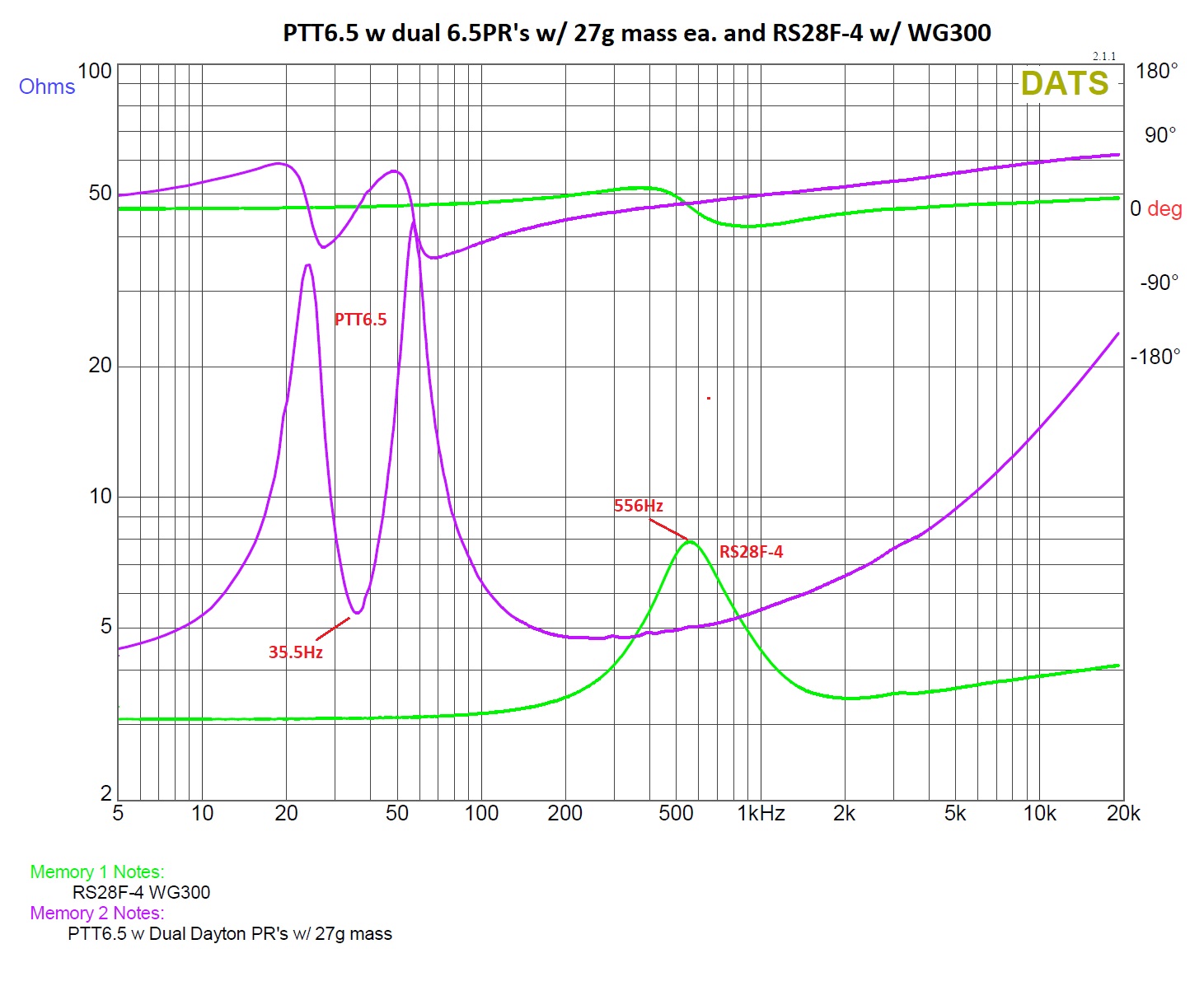
Thanks for your listening impressionss, Norman Tracy. Looking forward to hearing this beauty. Can you show schematic of your crossover or your crossover sim prediction? What volume is your box and what is the box resonant frequency?
Well, I now have the ZMA files. On to measuring the FRD's next. Then some doodling in Xsim to make a XO.
Thanks for your listening impressionss, Norman Tracy. Looking forward to hearing this beauty. Can you show schematic of your crossover or your crossover sim prediction? What volume is your box and what is the box resonant frequency?
Attachments
Great write up Norman. Imagine how good the pure woofers are going to be when they come out . . .
Saw the woofers on saturday for the first time in real life after having read so much about them.
Joachim Gerhard will use them in one of his new developments:
Joachim-Gerhard-Collection - Home | Facebook
No DIY, but anyway, I'll try to have a listen as soon as they'll be ready.
Joachim Gerhard will use them in one of his new developments:
Joachim-Gerhard-Collection - Home | Facebook
No DIY, but anyway, I'll try to have a listen as soon as they'll be ready.
Thanks Norman - Excellent detailed descriptions , wonderful review - you sold me... now where do I sign up .......
- New Audio magazine -- " Norman Tracy's Online Audio Review "
-- kinda catchy don't you think . . . 🙂
- New Audio magazine -- " Norman Tracy's Online Audio Review "
-- kinda catchy don't you think . . . 🙂
Was this linked here earlier? Puri Bliss - BeWg | HiFiCompass - всё для акустических систем и не только
So far only in Russian, but Google can translate. Check also driver measurements in English Measurements and compare | HiFiCompass

So far only in Russian, but Google can translate. Check also driver measurements in English Measurements and compare | HiFiCompass

- Hi fedde , I don't remember any negative side effects..... the only thing that one person said was that if you enclose the top of the wave guide he felt like you loose a little of the Airiness ( is that a word?) and a little of the great Depth of Field - so that's why at this point most are leaving the AMT drivers in the wave guides open at the top. The only other downside was that AMT - Heil driver has very narrow vertical directivity - But that Disappears when you Stack Two of them! Some people are crossing them down around 500Hz , some around 700Hz , and some around 1,000Hz. I think it just comes down to the best pattern control for that set of drivers and what sounds best.
-
Thank you, this is very interesting. I wonder whether the clarity and cleanness of the higher frequencies is not affected by having two sources on top of each other. The nice thing is in principle I could try the stacking with a mono channel before buying more drivers. This topic deserves an own thread on Diyaudio...
Fedde
Great write up Norman. Imagine how good the pure woofers are going to be when they come out . . .
Indeed nice to read this very positive review. So it appears that the relatively high mass and low efficiency does not affect the jump and startle factors.
Can you imagine what four of these in an open baffle could do...
😛
Fedde
Indeed nice to read this very positive review. So it appears that the relatively high mass and low efficiency does not affect the jump and startle factors.
Can you imagine what four of these in an open baffle could do...
😛
Fedde
The issue Fedde focuses in on "high mass and low efficiency does not affect the jump and startle factors" is certainly my biggest relief now the project has moved from application notes and datasheets to more systems playing in the real world. A year ago I was firmly in the camp that only light, efficient, large surface area cones could yield the sound I am enjoying. So much so it became the intuitively correct answer. Now I recast that opinion 'up to May 2020 I had only heard the very alive, dynamic, and present sound from large format speakers'.
PURIFI states the case here in their Dec 2019 blog post:
A fast driver needs a light cone. Or does it? - PURIFI
A resource for those building with PURIFI drivers that really helped me fast track my project is SMJ Audio. SMJ Audio
Based on my 2D drawings Steve Manning programmed and cut the front baffles for my Fi16v1, shown here before being stained black and sealed. Steve has other client's projects that use PURIFI drivers so he has the dimensions dialed in. I had him install the threaded inserts and they were perfectly positioned (because, calibrated CNC + operator skill). Given the cost of these woofers installing with 8-32 socket head screws is the way to go IMHO. I specified my preferred baltic birch ply, Steve also works in MDF, hardwoods, and (my next temptation) bamboo ply.
More of SMJ Audio's work shown here:
SMJ Audio Calliope MT Build - Page 3
Based on my 2D drawings Steve Manning programmed and cut the front baffles for my Fi16v1, shown here before being stained black and sealed. Steve has other client's projects that use PURIFI drivers so he has the dimensions dialed in. I had him install the threaded inserts and they were perfectly positioned (because, calibrated CNC + operator skill). Given the cost of these woofers installing with 8-32 socket head screws is the way to go IMHO. I specified my preferred baltic birch ply, Steve also works in MDF, hardwoods, and (my next temptation) bamboo ply.
More of SMJ Audio's work shown here:
SMJ Audio Calliope MT Build - Page 3
Attachments
Here is my plan. For LF, I ordered a pair of the SB Acoustics PR to try out. They don't have enough xmax unfortunately but I don't plan to listen too loud so they should be OK. I do regret not getting the Purifi ones.
For HF, I have 2 options. I got a pair of Heil AMT as well a couple of B&W Nautilus tweeters from my friend's speakers. The AMT is OK, but has issues above 10kHz. The B&W tweeters can go down to 2.5kHz but not much more. These are what I have available for now. meanwhile I will do some research for a better pair.
For HF, I have 2 options. I got a pair of Heil AMT as well a couple of B&W Nautilus tweeters from my friend's speakers. The AMT is OK, but has issues above 10kHz. The B&W tweeters can go down to 2.5kHz but not much more. These are what I have available for now. meanwhile I will do some research for a better pair.
Attachments
The issue Fedde focuses in on "high mass and low efficiency does not affect the jump and startle factors" is certainly my biggest relief now the project has moved from application notes and datasheets to more systems playing in the real world. A year ago I was firmly in the camp that only light, efficient, large surface area cones could yield the sound I am enjoying. So much so it became the intuitively correct answer. Now I recast that opinion 'up to May 2020 I had only heard the very alive, dynamic, and present sound from large format speakers'.
PURIFI states the case here in their Dec 2019 blog post:
A fast driver needs a light cone. Or does it? - PURIFI
It's a low Qe driver with a high Qm. In addition, there is very little stiffness from the surround. Total Kms (X) is reasonably low over a fairly large range of excursion. (..though not as good as the ES-140ti.)
It's somewhat ironic, that the (literal) limitation of this driver is the spider.
jmpsmash I was also close to pulling the trigger on that PR. Please post your impressions when you get it all together! I am also wishing I'd got the purifi PRs but they are spenny for PRs.
As was suggested at the beginning of this thread the sb26adc is a nice entry level (ish) tweeter that will get you down to 2khz easy enough, all while sounding pretty good too and has the ability to keep up with the woofer output.
My listening impressions so far are still very much inline with Normans. Just amazing what these things do. I listen to more ... modern music and still don't feel the need for sub-woofers in my listening room.
Edit: One thing I have noticed is the suspension of the woofer seems to have loosened up substantially since I first got it..
As was suggested at the beginning of this thread the sb26adc is a nice entry level (ish) tweeter that will get you down to 2khz easy enough, all while sounding pretty good too and has the ability to keep up with the woofer output.
My listening impressions so far are still very much inline with Normans. Just amazing what these things do. I listen to more ... modern music and still don't feel the need for sub-woofers in my listening room.
Edit: One thing I have noticed is the suspension of the woofer seems to have loosened up substantially since I first got it..
Last edited:
jmpsmash I was also close to pulling the trigger on that PR. Please post your impressions when you get it all together! I am also wishing I'd got the purifi PRs but they are spenny for PRs.
for sure will share my findings here. but might take a week or two.
I think this is a good plan. I have a slight OT question: how did you attach the RS28F to the waveguide? Do you have a tutorial/plan/design to look at? I'm interested.Also included is the impedance sweep of the Dayton RS28F-4 in a Visaton WG300 waveguide. It has a resonance down at 552Hz. If I cross at 1700Hz or so, this should work well.
Ralf
Here is my plan. For LF, I ordered a pair of the SB Acoustics PR to try out. They don't have enough xmax unfortunately but I don't plan to listen too loud so they should be OK. I do regret not getting the Purifi ones.
For HF, I have 2 options. I got a pair of Heil AMT as well a couple of B&W Nautilus tweeters from my friend's speakers. The AMT is OK, but has issues above 10kHz. The B&W tweeters can go down to 2.5kHz but not much more. These are what I have available for now. meanwhile I will do some research for a better pair.
Those b&w tweeters have seen better days 😱
I think this is a good plan. I have a slight OT question: how did you attach the RS28F to the waveguide? Do you have a tutorial/plan/design to look at? I'm interested.
Ralf
I made an adapter plate with 3D printing. I might have the STL but will have to check. My HD crashed a few years ago and this might have been one of the things lost. More details here:
RS28F-RS180P-B80 as Hole Filler 3-way
Although above thread is mostly about a 3 way B&O style hole-filler XO speaker that never was fully made. 2/3rds of that speaker was used with the PTT6.5 which was a drop in fit for the RS180P (which, BTW is not a good driver - inherently high distortions when measured). I’ll post results of my marriage of the PTT6.5 and RS28F in WG300 shortly. I ended up crossing much higher because the PTT6.5 is so capable and clean up to even 3500Hz. In some ways, it may be A fine midrange and even competes with the venerable 3in fabric soft domes from ATC/Volt in the area of low distortion and clarity - except for it doesn’t have 94dB sensitivity.
- Home
- Loudspeakers
- Multi-Way
- Exploring Purifi Woofer Speaker Builds
